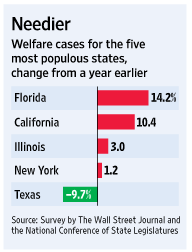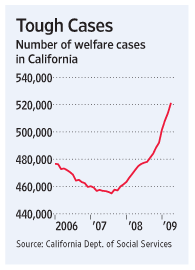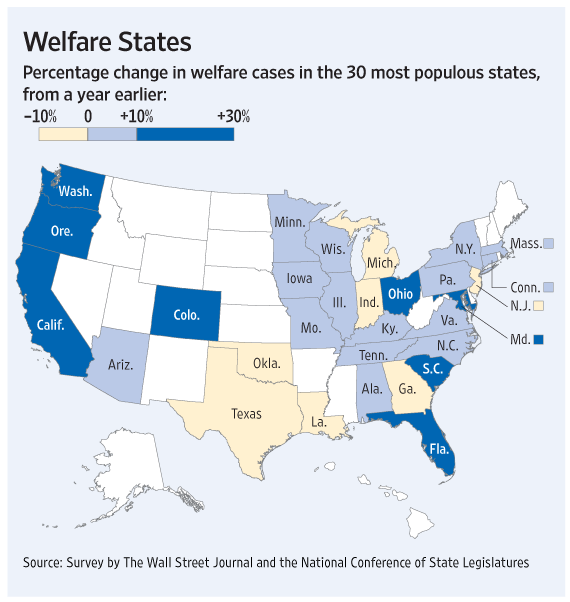Hopefully a trend is not starting !
By SARA MURRAY
Welfare rolls, which were slow to rise and actually fell in many states early in the recession, now are climbing across the country for the first time since President Bill Clinton signed legislation pledging “to end welfare as we know it” more than a decade ago.
Twenty-three of the 30 largest states, which account for more than 88% of the nation’s total population, see welfare caseloads above year-ago levels, according to a survey conducted by The Wall Street Journal and the National Conference of State Legislatures. As more people run out of unemployment compensation, many are turning to welfare as a stopgap.
The biggest increases are in states with some of the worst jobless rates. Oregon’s count was up 27% in May from a year earlier; South Carolina’s climbed 23% and California’s 10% between March 2009 and March 2008. A few big states that had seen declining welfare caseloads just a few months ago now are seeing increases: New York is up 1.2%, Illinois 3% and Wisconsin 3.9%. Welfare rolls in a few big states, Michigan and New Jersey among them, still are declining.
The recent rise in welfare families across the country is a sign that the welfare system is expanding at a time of added need, assuaging fears of some critics of Mr. Clinton’s welfare overhaul who said the truly needy would be turned away.

“To me it’s good news,” says Ron Haskins of the Brookings Institution, who helped draft the 1996 welfare-overhaul law as a Republican congressional staff member. “This is exactly what should happen.”
Welfare cases peaked at above five million in 1995 and declined sharply after the 1996 law put time limits on benefits and emphasized moving recipients from welfare to work. The time limits vary by state, but the federally mandated maximum is five years with some exceptions; after that, benefits end.
The cash-assistance program, called Temporary Assistance for Needy Families (TANF), was created by the 1996 law and replaced previous welfare and jobs-training programs. Funded partly by the federal government and partly by the states, it primarily assists women who have children and no job, or a very low-paying one. The number of families on welfare had been falling steadily and, nine months into the recession, stood at 1.6 million in September 2008, the most recent date for which national tallies are available.
‘First Real Test’
“This is the first real test,” said Liz Schott, a welfare analyst at the Center on Budget and Policy Priorities, a liberal Washington think tank. “We always said, how is it going to perform? How is TANF going to perform in an economic downturn?”
One clue, she says, can be found in a different measure. Although the TANF program seems to be accommodating increased need, it is doing so at a slower rate than another government initiative: the food-stamp program. The number of food-stamp recipients has risen in every state and was 19% higher in March than a year ago, a much bigger increase than the number of welfare cases.

Food-stamp eligibility is significantly easier than the criteria for receiving welfare, so food-stamp assistance tends to rise first. The food-stamp program covers a much larger pool of people who have trouble making ends meet but make more money than the allowable limits under TANF.
In general, a family of four must have a monthly income of less than $2,297 to qualify for food stamps. Welfare, on the other hand, is designed as a last resort.
The average monthly welfare benefit in 2006, which reflects the most current data collected by the government, was $372.
Antoinette Tatum has been receiving food stamps since September when she and her 4-year-old daughter moved to Kensington, Md. When her car transmission failed, Ms. Tatum couldn’t commute to her job in Baltimore, about 45 minutes away by car, so she quit. Unable to find a full-time job, Ms. Tatum did temporary work but found that the more she earned, the fewer government benefits she received; ultimately she couldn’t make ends meet.
“The government, they help the extremes. But people in between have the hardest time,” said Ms. Tatum, 28. “You don’t make enough money to get by but you make too much to get help.” She turned to welfare, and expects to begin getting checks at the end of this month. She is considering staying on welfare and going to college instead of seeking another low-wage job.
Interactive Link
The recession is straining many state welfare programs. State budget woes often mean more cases without more employees. And the demand for cash assistance is squeezing funds for job-training programs targeted both at the unemployed with little work experience and unemployed professionals with extensive work experience.
In South Carolina, for example, the vast majority of welfare funding is being directed to the cash-assistance program, leaving little to actually help people find jobs and get off welfare. “When we really are talking about how to put people back to work or get them retrained, with the budget problems our state is having, I really worry,” says Sue Berkowitz, the director of the South Carolina Appleseed Legal Justice Center, which advocates for low-income people.
Stimulus Grants
The federal government’s fiscal stimulus includes $5 billion for states where more families receive welfare or spending increases on employment subsidies or short-term emergency assistance. That provision sparked concerns from the Heritage Foundation and other conservative groups that President Barack Obama was undoing the provisions of the 1996 law intended to encourage states to get people off welfare and onto payrolls.
So far, only California and Ohio have received stimulus grants, but 38 other states and territories said they plan to apply, said Jeffrey Kelley, spokesman for the Department of Health and Human Services’ Administration for Children and Families.
The lag in the increase in welfare cases during the worst recession in a generation is curious to some some scholars. “In many respects, the mystery that had been operating until now had been how can there be such a rapid increase in unemployment and long-term unemployment and not show up in the welfare [system]?” says Mark H. Greenberg, director of Georgetown University’s Center on Poverty, Inequality and Public Policy.
The extension of unemployment benefits by Congress — for as long as 59 weeks in some states — may be one reason.
“To some extent unemployment [compensation] is doing what we hoped it would do, which is being the first safety net for unemployed workers,” says Don Winstead, the deputy secretary of Florida’s Department of Children and Families. Without those extensions, he added, the number of families on welfare in Florida would have risen even more than it has: up 14% in June versus a year ago.
Another cause of the delay may be that welfare is targeted at women and children, and this recession has been hardest on men. The lag in the increase in welfare cases may simply show that it took longer for the recession to hurt women than men, says Mr. Haskins of the Brookings Institution.

Despite the deep recession, a few big states still have declining welfare rolls.
In Michigan, for example, welfare caseloads were down 4.8% in April from a year ago even though the number of residents receiving food stamps was up 13% in March to more than 1.4 million people. Some advocacy groups for the poor complain that strict front-end requirements — which force welfare recipients to look for work in a state with a 14% unemployment rate before even meeting with a caseworker — deter many from seeking help.
A further explanation is that income limits for welfare eligibility are set so low, and haven’t been adjusted for so long, that having a low-wage part-time job can disqualify an applicant. In New Jersey, a family of three earning more than $636 a month is ineligible. “These are the people who really will fall through the cracks because they’re not eligible for any help,” says Donna Gapas, who oversees the welfare program in Hunterdon County, N.J.
Comments »



